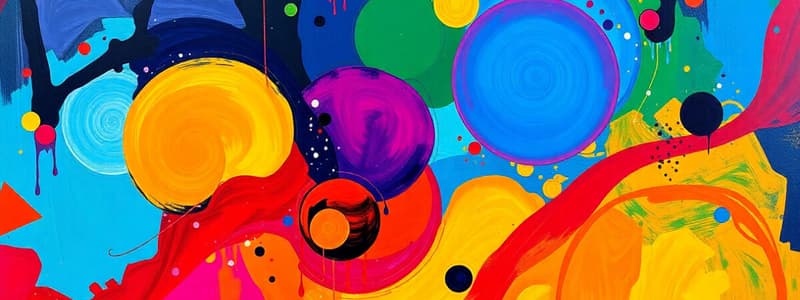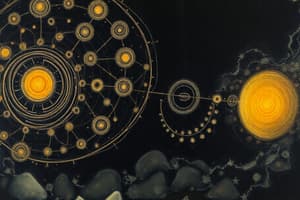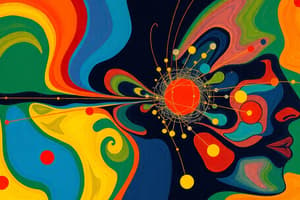Podcast
Questions and Answers
What is the role of photoreceptors in the visual system?
What is the role of photoreceptors in the visual system?
- To process light waves into meaningful images
- To interpret visual information in the occipital lobe
- To detect light waves and transmit information to the brain (correct)
- To convert visual signals into sound waves
How does the absolute threshold differ from the difference threshold?
How does the absolute threshold differ from the difference threshold?
- Absolute threshold varies by sensory modality, while difference threshold remains constant across modalities
- Absolute threshold measures intensity, while difference threshold measures frequency
- There is no real difference; they are synonymous terms
- Absolute threshold refers to the minimum intensity required for detection, while difference threshold refers to the smallest detectable change in stimulus intensity (correct)
Which sensory modality processes airborne molecules?
Which sensory modality processes airborne molecules?
- Taste
- Smell (correct)
- Hearing
- Touch
In which part of the brain is auditory information primarily processed?
In which part of the brain is auditory information primarily processed?
What does the term 'transduction' refer to in the context of sensation?
What does the term 'transduction' refer to in the context of sensation?
Which Gestalt principle describes the tendency to perceive incomplete shapes as complete?
Which Gestalt principle describes the tendency to perceive incomplete shapes as complete?
What aspect of perception involves understanding spatial relationships through cues?
What aspect of perception involves understanding spatial relationships through cues?
Which receptors are responsible for the sensation of pain?
Which receptors are responsible for the sensation of pain?
What is the primary function of the gustatory cortex?
What is the primary function of the gustatory cortex?
Which of the following best describes adaptation in sensory systems?
Which of the following best describes adaptation in sensory systems?
Which phenomenon exemplifies the interaction between auditory and visual inputs in speech perception?
Which phenomenon exemplifies the interaction between auditory and visual inputs in speech perception?
What is a characteristic of Sensory Processing Disorder (SPD)?
What is a characteristic of Sensory Processing Disorder (SPD)?
Which condition refers to the inability to recognize objects despite having functioning senses?
Which condition refers to the inability to recognize objects despite having functioning senses?
Which cue is NOT classified as a monocular cue for depth perception?
Which cue is NOT classified as a monocular cue for depth perception?
What is an application of sensory and perceptual research in healthcare?
What is an application of sensory and perceptual research in healthcare?
Which principle emphasizes the brain's role in organizing sensory inputs?
Which principle emphasizes the brain's role in organizing sensory inputs?
Which of the following is an example of cross-modal sensory experience?
Which of the following is an example of cross-modal sensory experience?
In the context of depth perception, linear perspective refers to:
In the context of depth perception, linear perspective refers to:
What does the term 'multimodal perception' refer to?
What does the term 'multimodal perception' refer to?
What is NOT a common application of sensory and perceptual research in technology?
What is NOT a common application of sensory and perceptual research in technology?
Flashcards
Transduction
Transduction
The process of converting physical stimuli into neural signals.
Absolute Threshold
Absolute Threshold
The minimum intensity of a stimulus needed for detection.
Difference Threshold
Difference Threshold
The smallest detectable difference in stimulus intensity.
Adaptation
Adaptation
Signup and view all the flashcards
Perception
Perception
Signup and view all the flashcards
Sensation
Sensation
Signup and view all the flashcards
Proximity
Proximity
Signup and view all the flashcards
Similarity
Similarity
Signup and view all the flashcards
Closure
Closure
Signup and view all the flashcards
Continuity
Continuity
Signup and view all the flashcards
Multimodal Perception
Multimodal Perception
Signup and view all the flashcards
McGurk Effect
McGurk Effect
Signup and view all the flashcards
Phantom Limb Syndrome
Phantom Limb Syndrome
Signup and view all the flashcards
Agnosia
Agnosia
Signup and view all the flashcards
Sensory Processing Disorder (SPD)
Sensory Processing Disorder (SPD)
Signup and view all the flashcards
Monocular Cues
Monocular Cues
Signup and view all the flashcards
Gestalt Principles
Gestalt Principles
Signup and view all the flashcards
Texture Gradient
Texture Gradient
Signup and view all the flashcards
Interposition
Interposition
Signup and view all the flashcards
Linear Perspective
Linear Perspective
Signup and view all the flashcards
Study Notes
Sensation and Perception
- Sensation is detecting physical stimuli (e.g., light, sound, pressure) and transmitting the information to the brain
- Perception is the brain organizing and interpreting sensory information to form meaningful experiences
- Studying sensation and perception helps understand human interaction with the world and how sensory inputs are integrated with cognitive processes
Sensory Modalities
-
Vision:
- Light waves detected by photoreceptors in the retina
- Processed in the visual cortex of the occipital lobe
-
Hearing (Audition):
- Sound waves detected by hair cells in the cochlea
- Processed in the auditory cortex of the temporal lobe
-
Touch (Somatosensation):
- Pressure, temperature, and pain detected by mechanoreceptors, thermoreceptors, and nociceptors
- Processed in the somatosensory cortex of the parietal lobe
-
Taste (Gustation):
- Chemicals in food detected by taste buds on the tongue
- Processed in the gustatory cortex of the insula
-
Smell (Olfaction):
- Airborne molecules detected by olfactory receptors in the nasal cavity
- Processed by the olfactory bulb and the limbic system
Processes of Sensation and Perception
-
Transduction: Converting physical stimuli into neural signals (e.g., light to electrical signals in the retina)
-
Thresholds:
- Absolute Threshold: The minimum intensity of a stimulus needed to be detected
- Difference Threshold (Just Noticeable Difference): The smallest difference in stimulus intensity that can be detected
-
Adaptation: Decreased sensitivity to a constant stimulus over time (e.g., adjusting to a strong smell in a room)
Perceptual Organization
-
Gestalt Principles: Organizing sensory information, including:
- Figure-Ground: Distinguishing an object from its background
- Proximity: Grouping close elements together
- Similarity: Grouping similar elements together
- Closure: Perceiving incomplete shapes as complete
- Continuity: Preferring smooth, continuous patterns
-
Depth Perception: Integrating binocular and monocular cues for spatial relationships, including:
- Binocular Cues: Retinal disparity and convergence
- Monocular Cues: Linear perspective, texture gradient, interposition
Multimodal Perception
- Integration of information from multiple senses to create a unified perception (e.g., McGurk Effect, Synesthesia)
Disorders of Sensation and Perception
- Sensory Processing Disorder (SPD): Difficulty effectively integrating sensory input
- Phantom Limb Syndrome: Sensation of pain or presence in an amputated limb
- Agnosia: Inability to recognize objects, sounds, or smells despite intact sensory function
Applications of Sensory and Perceptual Research
- Technology and Design: Developing user-friendly interfaces and virtual reality systems
- Healthcare: Treating sensory impairments (e.g., cochlear implants)
- Education: Understanding sensory integration for teaching children with sensory processing challenges
Key Takeaways
- Sensation and perception are essential for creating meaningful experiences
- Gestalt principles and depth perception highlight brain organization of sensory input
- Multimodal perception shows how senses work together to understand the environment
Studying That Suits You
Use AI to generate personalized quizzes and flashcards to suit your learning preferences.




